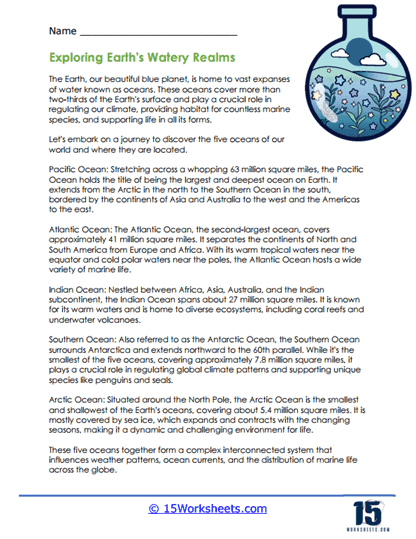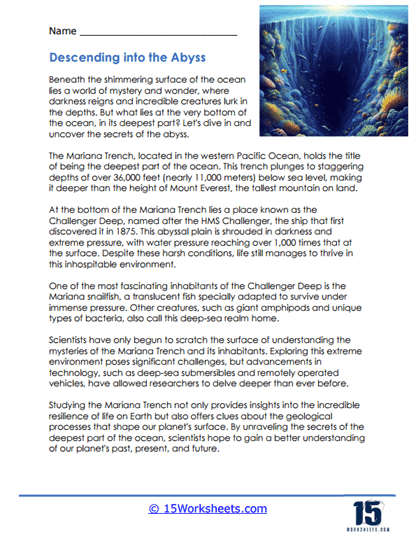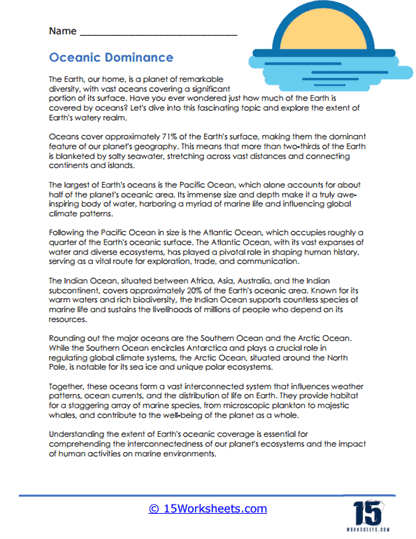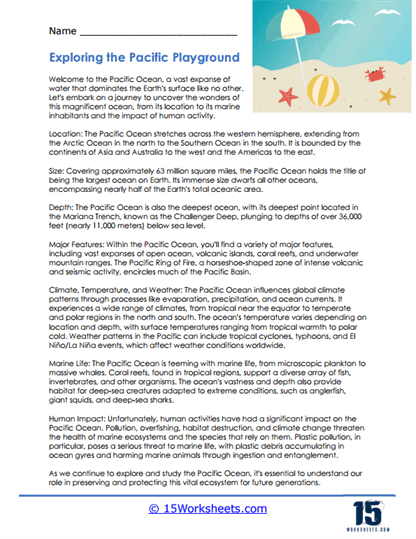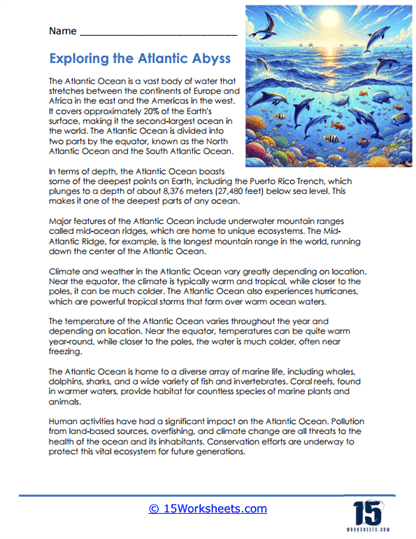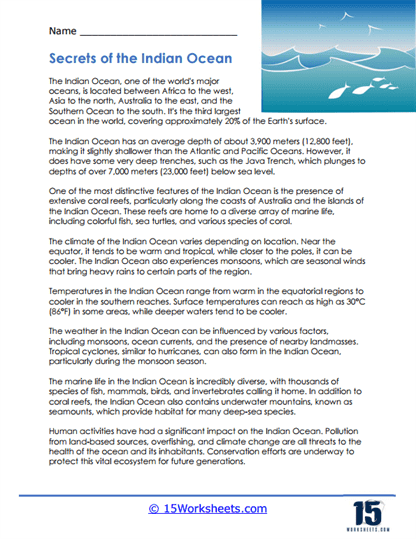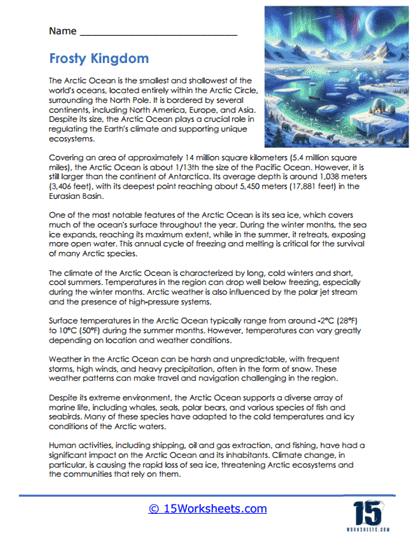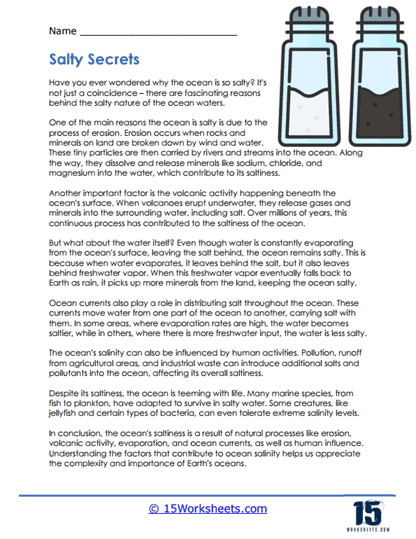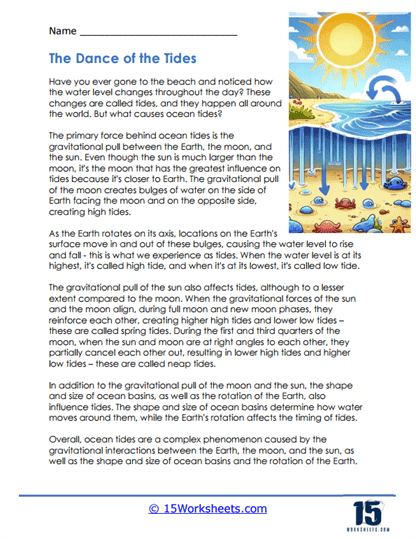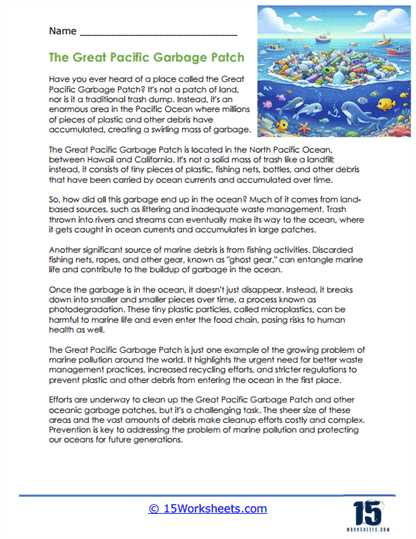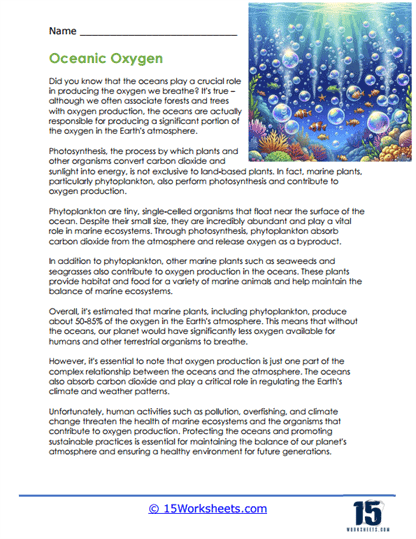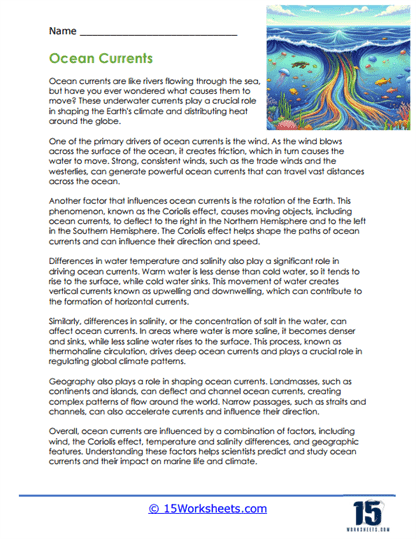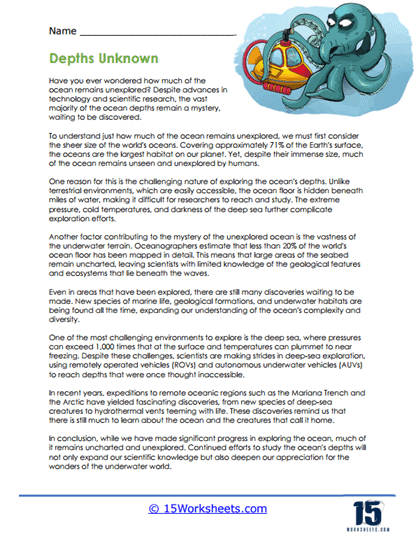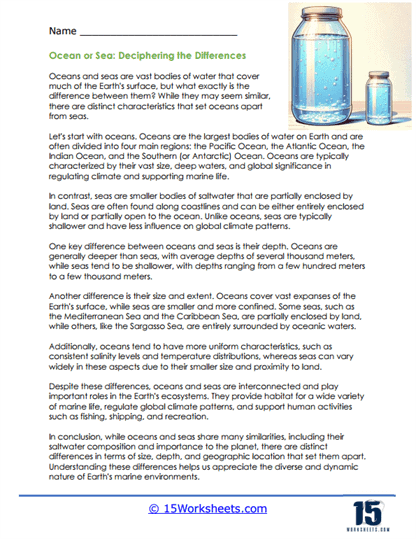Oceans Worksheets
About These 15 Worksheets
Ocean worksheets are educational tools designed to help students explore and understand the vast and complex ecosystems of the world’s oceans. These worksheets cover a range of topics, including marine life, oceanography, the physical properties of oceans, and human impacts on these ecosystems. By engaging with different types of exercises found on these worksheets, students can deepen their knowledge of the ocean, its importance to Earth’s overall ecosystem, and the role it plays in global environmental health.
Through a variety of engaging exercises, these worksheets foster a comprehensive understanding of marine environments and encourage a lifelong interest in science and conservation.
Types of Exercises
Reading Comprehension Questions – These exercises provide students with informative texts about various oceanic topics, such as ocean currents, the water cycle, marine biodiversity, and conservation efforts. After reading, students answer questions that test their understanding of the text. This helps improve their ability to extract key information and comprehend complex scientific concepts.
Labeling Diagrams – Worksheets may include diagrams of oceanic processes (like thermohaline circulation), parts of marine animals (like the anatomy of a fish or a coral polyp), or different ocean zones (like the epipelagic and abyssal zones). Labeling these diagrams helps students visualize and remember the physical aspects of the ocean and its inhabitants.
Matching Exercises – These might involve matching marine species to their descriptions, ocean terms to their definitions, or images of oceanic features to their names. Matching exercises help students quickly learn and recall specific facts and concepts.
Multiple-Choice and True/False Questions – These are used to assess students’ knowledge of facts and concepts related to the ocean, such as the causes of tides, types of marine ecosystems, and the effects of ocean acidification. They provide a quick and effective way to review and test comprehension.
Creative Writing Prompts – Prompts might ask students to write a day in the life of a marine biologist, create a story about a journey through the Mariana Trench, or argue a position on an ocean conservation issue. These exercises enhance students’ writing skills while encouraging them to think creatively and empathetically about marine life and environmental issues.
Discussion Questions – These encourage students to think deeply about issues such as the ethical implications of deep-sea mining or the global effects of melting sea ice. Discussions help students develop their reasoning and debate skills.
The Benefits of These Worksheets
Enhanced Understanding of Environmental Science – By exploring the complexities of ocean systems, students gain a greater appreciation for the field of environmental science and understand how oceans influence global climate, weather patterns, and biodiversity. Regular practice with diverse types of exercises enhances reading comprehension, writing ability, analytical thinking, and scientific literacy.
Awareness of Conservation Needs – Learning about the threats to oceanic ecosystems, such as pollution, overfishing, and climate change, heightens students’ awareness of the need for conservation and sustainable practices.
Development of Critical Thinking – Analyzing data, solving problems, and engaging in discussions about environmental issues fosters critical thinking skills, which are essential for academic success and responsible citizenship. Ocean worksheets integrate concepts from geography, chemistry, physics, and mathematics, providing a multidisciplinary approach to learning that prepares students for complex real-world problems. Understanding the oceans encourages a global perspective, helping students see beyond their immediate environment to the broader world processes and interconnections.
What Are The Oceans of the World?
The world’s oceans are vast bodies of saltwater that cover approximately 71% of the Earth’s surface, serving as major components of the planet’s hydrosphere. Each ocean has unique characteristics, including distinct flora and fauna, physical features, and environmental roles. There are five recognized oceans – the Pacific, Atlantic, Indian, Southern, and Arctic Oceans.
1. Pacific Ocean
Location – The Pacific Ocean is the largest and deepest ocean, extending from the Arctic Ocean in the north to the Southern Ocean in the south, and bounded by Asia and Australia on the west and the Americas on the east.
Size and Depth – It covers more than 63 million square miles and reaches its deepest point at the Mariana Trench, which is about 36,070 feet deep.
Marine Life – The Pacific supports an extensive range of marine ecosystems, from coral reefs in the shallower regions to deep-sea vents.
Environmental Impact – It plays a critical role in weather patterns, particularly through phenomena like El Niño and the Pacific Decadal Oscillation.
2. Atlantic Ocean
Location – The Atlantic Ocean lies between the Americas to the west and Europe and Africa to the east, stretching from the Arctic Ocean in the north to the Southern Ocean in the south.
Size – It is the second largest ocean, covering over 41 million square miles.
Ocean Ridge – The Mid-Atlantic Ridge, a massive underwater mountain range with a central rift valley, is a prominent feature and is associated with seafloor spreading.
Climate Influence – The Gulf Stream, a major ocean current originating in the Gulf of Mexico and flowing into the Atlantic, significantly influences the climate of the adjacent land areas, especially Western Europe.
3. Indian Ocean
Location – The Indian Ocean is bordered by southern Asia to the north, Australia to the east, Africa to the west, and merges with the Southern Ocean to the south.
Size – It covers about 27.2 million square miles, making it the third-largest ocean.
Marine Life – It is known for its diverse marine ecosystems, including those around the many islands and archipelagos within it.
Economic Importance – The ocean is a vital route for oil transport and also has significant fishing and maritime industries along its rim.
4. Southern Ocean
Location – Also known as the Antarctic Ocean, it encircles Antarctica and is generally defined to extend from the coast of Antarctica to 60 degrees south latitude, excluding the Pacific, Atlantic, and Indian Oceans.
Cold Waters – The Southern Ocean is the coldest of all the oceans.
Circumpolar Current – It is home to the Antarctic Circumpolar Current, which moves more water than any other ocean current, mixing water masses and distributing heat and energy around the planet.
Ice Cover – Seasonal and permanent ice packs, significant for global climate regulation, are prevalent here.
5. Arctic Ocean
Location – The Arctic Ocean is located mostly in the Arctic Circle and is bordered by Eurasia and North America.
Size – It is the smallest and shallowest of the world’s five major oceans.
Ice Coverage – Much of the ocean is covered by sea ice that varies seasonally in extent.
Environmental Sensitivity – The Arctic Ocean is particularly sensitive to climate change, and its melting ice has profound implications for global sea levels and ecological balance.
Each of these oceans plays crucial roles in environmental regulation, including carbon cycling and climate modulation. Oceans are also central to global shipping routes, geopolitical strategies, and economic activities, such as fishing and mining. Understanding these bodies of water is essential for sustainable management and conservation efforts, given their impact on global ecosystems and human livelihoods.

